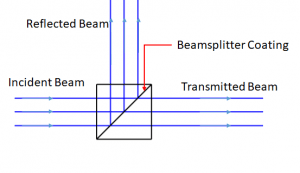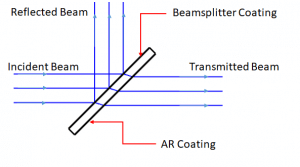A beam splitter (or beamsplitter) is an optical component used for splitting light into two separate beams, usually by wavelength or polarity. It can also be used, in reverse, as a beam combiner, to join two light beams into one. These specialty mirrors have applications in many fields, including laser, semiconductor and phototonics instrumentation.
Cube Beamsplitter
Cubic beamsplitters usually consist of two right angle prisms that are carefully cemented together with optical glue. The thickness of the optical glue depends on the wavelength of light in the intended application. One inner surface of one of the prisms are coated with a partially reflective metal di-electric coating.
The cube should always be oriented so that incident light enters the coated prism, in order that energy passing through the optical cement is minimized. Entering through the wrong side will cause more than triple the amount of energy to pass through the delicate cement layer. If used in this way with high power light sources, the cement may degrade over time. We place a reference mark on the ground side of the coated prism to make it easy to orient your cube correctly.
These cube beam splitters have no beam shift and can be easily integrated with 0 degree angle of incidence. The reflected and transmitted optical path lengths will be equal. Compared to other options, they allow you to shorten the optical path of a system. Their only disadvantages are the heavy construction—each piece is solid glass – and the fact that they are both difficult and expensive to make in large sizes. We recommend these beamsplitters in situations where a simplified mounting is important and durability is premium.
Cube beamsplitter diagram:

Plate Beamsplitter
Plate beamsplitters, on the other hand, are lighter and less expensive, and they can be easily manufactured in any size. They consist of a flat, thin glass plate, with a coating on the first surface of the substrate. It is this coating which splits the incident beam by a specified ratio. The reflected and transmitted optical paths will have different lengths, and there will be a beam shift in transmitted light. Although these optics are often designed for a 45 degree angle of incidence, setup may require extra alignment time. Plate beam splitters are cheaper to manufacture than are cube beamsplitters.
Plate beamsplitter diagram:

| Memory | |
| test 1 | Lateral Displacement Beamsplitters |
Beam splitters
- Brand: ALAXY
- Product Code: Custom Lenses
- Availability: In Stock
- $480.80
-
$308.00
- Ex Tax: $255.00
Tags: Beam splitters




